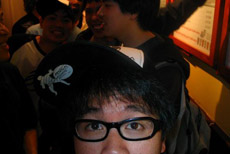
It was always going to be an interesting collaboration, not simply because of the multi-disciplinary and multi-national backgrounds of the artists involved in this second installment of INSITU, but also the context of the subject of their work – Fort Canning Hill in Singapore. Known as the Forbidden Hill in pre-colonial times because of its believed designation as the burial site of Malay royalty, the Hill was subseqeuntly appropriated by the British as Government Hill and later fortified and named after the Governor General of India. No longer a fort today, the hill nonetheless remains a site bearing much historical and geographical significance.
INSITU Fort Canning began with a quote from David Mazzucchelli from his graphic novel Asterios Polyp on the re-creative character of memory, something that is actively constructed in the present when summoned. This was appropriate considering how the audio, visual, textual and performative responses of the artists – Kangding Ray, Taisuke Koyama, June Yap and Boedi Widjaja respectively – attempted to actively engage with memory not as a relic of the past but as a conversation between the past and present, a mapping of the relationship between the historical and biographical, between subject and artist.
Photographer Taisuke Koyama, for example, could not neglect his personal response to the hill as situated within his identity as a Japanese and his attempt to deal with the hill’s history during the Japanese Occupation. For curator and writer June Yap, it was the interweaving of historical narratives with present-day ones in a semi-fictional recited text. And through the perspective of visual artist and project founder Boedi Widjaja, INSITU was birthed from his personal struggle with the problematic process of remembering home. It’s no wonder that the force of each artist’s work resonated powerfully, especially Widjaja’s routine involving the rhythmic clashing of chalk against paper on a table top, a performance that was personally catharthic whilst more broadly symbolic of the violence enacted on the hill via its many rewritten scripts through time.
You could say that as a whole, it was the soundtrack by Berlin-based artist Kangding Ray that strung the performance together, not in a unifying way but as held in precarious tension. Beginning with traditional gamelan and setting the tone with his own field recordings on the hill, KR proceeded to explore the space by introducing his distinct brand of bass-heavy electronica. While the local(ized) sounds are embraced as intimate contextual engagements with the hill, KR’s own material tended to exist on a different level of abstraction, and it is here that his intervention might be considered most divisive. One wonders, for instance, if it feels somewhat decontextualised from the rest of the artists’ contributions; yet, it smartly avoids the trap of literalism by choosing to express itself through a deliberately foreign sound, one that communicates most forcefully through the varying intensities of rhythm and the careful shifts in sonic textures.
Kangding Ray’s approach captures nicely the broader dynamics of collaboration in INSITU Fort Canning, with its discontinuities and interpretations that tend to vacillate between the hill’s primary contexts and tangents of extrapolation that are not immediately obvious. It is this degree of uncertainty and complexity of responses that is ultimately the most fitting tribute to the Hill itself, with its vast and multi-faceted histories embedded within, both told and untold, speakable and unspeakable. – Dan.
mp3: Kangding Ray – World Within Words – from Automne Fold (2008)
INSITU Fort Canning was organized by Singapore-based art practice Beautiful / Banal. Kangding Ray’s latest album Or is now out on raster-noton.




























